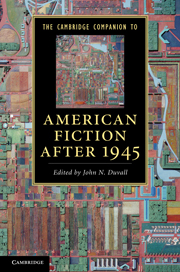Book contents
- Frontmatter
- Introduction: A story of the stories of American fiction after 1945
- PART I POETICS AND GENRES
- 1 Postmodern metafiction
- 2 Contemporary realism
- 3 New journalism and the nonfiction novel
- 4 Science fiction
- 5 The short story
- PART II HISTORICAL AND CULTURAL CONTEXTS
- PART III MAJOR AUTHORS
- Conclusion: Whither American fiction?
- Index
- Cambridge Companions to …
3 - New journalism and the nonfiction novel
from PART I - POETICS AND GENRES
Published online by Cambridge University Press: 28 March 2012
- Frontmatter
- Introduction: A story of the stories of American fiction after 1945
- PART I POETICS AND GENRES
- 1 Postmodern metafiction
- 2 Contemporary realism
- 3 New journalism and the nonfiction novel
- 4 Science fiction
- 5 The short story
- PART II HISTORICAL AND CULTURAL CONTEXTS
- PART III MAJOR AUTHORS
- Conclusion: Whither American fiction?
- Index
- Cambridge Companions to …
Summary
When John Hersey ended the first chapter of Hiroshima (1946) by describing the burial of Toshiko Sasaki beneath the rubble of the East Asia Tin Works, his decision to focus “principally and first of all” on the bookcases that collapsed upon her on August 6, 1945, signaled his feelings about the collapse of available literary forms, all of which proved inadequate to convey the devastation of the atom bomb that he was trying to recreate. In this recognition of the limitations of existing narrative forms, Hersey anticipated by two decades one of the primary impulses behind the emergence of new journalism and the nonfiction novel, twin phenomena whose birth date, as John Hellmann argues, can be given as 1965, the year that saw the publication of Tom Wolfe's first essay collection, The Kandy-Kolored Tangerine-Flake Streamline Baby, and the serialization of Truman Capote's In Cold Blood in The New Yorker. The other primary impulse comes by way of a story Hunter S. Thompson tells about standing beside a Lear Jet that Richard Nixon is about to board during his 1968 presidential election campaign and being frantically thrust aside when a Nixon aide realizes he is smoking one Marlboro after another over the fuel tank. Thinking he can defend himself by reminding the advance man that he is a “sane, responsible journalist” who, otherwise, might have hurled his flaming Zippo into the tank, Thompson is exposed for the precise kind of journalist he is by the man who easily sees through the (il)logic of his reasoning: “Egomaniacs don't do that kind of thing … You wouldn't do anything you couldn't live to write about.”
- Type
- Chapter
- Information
- The Cambridge Companion to American Fiction after 1945 , pp. 44 - 55Publisher: Cambridge University PressPrint publication year: 2011

